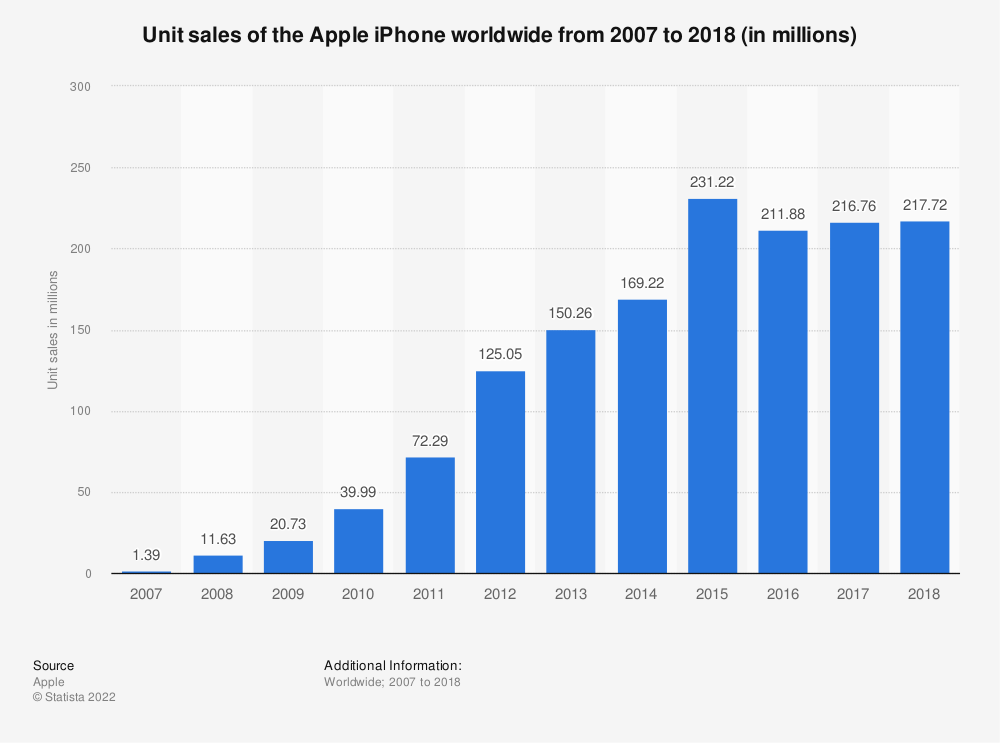Understanding Apple’s Decreased iPhone Sales
This past holiday quarter was a notable one for Apple, albeit for the wrong reasons. The November release of the iPhone X was highly anticipated, with the phone touting new innovative features such as an edge-to-edge display sans home button, wireless charging, and an intelligent facial recognition system.
Given that the latest of Apple’s smartphones to receive a design makeover was the iPhone 6 in 2015, analysts forecasted that the launch of the iPhone X would spur a “super cycle” that would boost the company’s sales and earnings. Top analyst Toni Sacconaghi at Bernstein made his prediction based on the dependable and massive “installed base” of iPhone users and the consistent annual upgrade rate.
Despite the hype, this Christmas season marked the first time that iPhone sales declined during the holiday quarter since Apple’s first smartphone launched under the beloved leadership of the late Steve Jobs. While Apple sold 78.3 million iPhones in the last quarter of 2016, that number declined 1.3% during the same period in 2017 with only 77.3 million phones sold. Perhaps due to these limp holiday sales, a report in Nikkei Asian Review indicated that Apple plans to reduce its production of iPhone X units in half this year, from an original 40 million to approximately 20 million.
Decreased demand is also reflected in reports of stagnant recruitment from Hon Hai Precision Industry Co.’s main iPhone manufacturing hub in Zhengzhou China. Despite this seemingly discouraging data, Apple CEO Tim Cook speaks of the iPhone X with pride. Addressing recent claims of weak demand and manufacturing cuts, Cook states that the iPhone X has been the top-selling phone every week and currently stands as the best-selling smartphone in the world.
What’s the Cause?
If the iPhone X is as supernal a product as Cook claims, what explains the sales dip? One factor may be the device’s hefty price. With the iPhone X retailed at nearly $1,000 a pop, even the most loyal iPhone fans may be choosing to stick with their older smartphone models until the blow to their pocketbooks subsides over time. While the price tag may be a cause of lower sales, Apple faces something of a catch-22.
Cutting the price to spur purchases may compromise Apple’s profits and premium image. However, by maintaining the luxurious $1,000 price point, Apple’s flagship device faces the blow of the current sales figures. Despite all of this, data suggests that uptake by users of the new generation of devices is actually significantly slower than it was for the iPhone 7, meaning that price may not be a salient factor in declined sales.
While Apple admitted to slowing down old iPhones (apparently only the ones with low-capacity batteries), users are less keen on acquiring the latest Apple product than they were in the past. Perhaps this is due to the fact that, as some tech commentators point out, Apple products are demonstrating a lack of innovation.
The iPhone X’s new OLED screen is beautiful, yet Samsung was the first to implement it in the Samsung Galaxy S8. The thinner display and wireless charging are also features found in rival brands’ products.
Furthermore, although the facial recognition system appears futuristic and dazzling, it has been condemned as “glitchy” and can therefore be seen only as a crude attempt at innovation. While we can continue to postulate a variety of reasons for the decline in iPhone sales, it’s apparent that many interrelated factors come into play.
So What Does This Mean?
While the amount of iPhone X units sold appears underwhelming in light of the forecasted “super cycle,” Apple stands strong as a tech giant. Apple’s Q1 2018 financial results represent the company’s highest ever quarterly revenue to date. Cook reports that Apple’s “Other Products” bucket, including items like the Apple Watch, iPods, AirPods, and other appurtenances, generated $3.23 billion in the final quarter of 2017, up a staggering 36% from last year. Even with a relatively large share of iPhone owners sticking with their older phones for a while, the higher price tag adequately fills the gap created by the decrease in demand. Therefore, smartphone sales still eke out some revenue. With the iPhone standing as the number one smartphone worldwide, a large user base suggests that, even if individuals aren’t rushing to purchase the iPhone X immediately, they most likely will later on.

Find more statistics at Statista
Growth in the smartphone industry may have overall reached a plateau. According to Strategy Analytics, global smartphone shipments declined 9% annually from 438.7 million units in Q4 2016 to 400.2 million in Q4 2017. This is the biggest annual fall in smartphone history.
Despite this data, the number of smartphone owners is forecasted to continue growing. As our society grows evermore dependent on technology, the need to stay connected becomes increasingly important. As we mentioned in our recent blog post, 2017 was a phenomenal year for the mobile app economy and 2018 promises to see the continuing emergence of cutting-edge technological tools and solutions. While less users are rushing to buy the latest iPhone, technology continues to play a crucial and ubiquitous role in our daily lives. At Guarana, we are proud to be your end-to-end resource for iOS development and mobile app development in Toronto and Montreal.
.jpg?width=1280&height=854&name=img-bbox-0%20(2).jpg)
by
Guarana
Filed under App Funding
Tagged
Iphone,
Apple,
Iphone X,
Smartphone